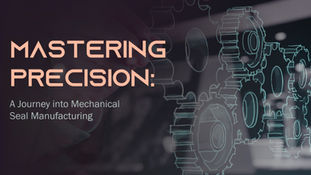
How Mechanical Seal Design Affects Equipment Reliability and Longevity
Aug 6, 2024
3 min read
0
3
0
Introduction
In the intricate world of machinery and industrial equipment, the significance of mechanical seals often goes unrecognized, yet their impact on the reliability and lifespan of equipment is profound. These seals, designed to prevent fluid leaks in rotating equipment, play a pivotal role in ensuring the seamless operation of critical processes in various industries. Let's delve into how the design of mechanical seals significantly influences the reliability and longevity of equipment.

1. Seal Performance And Efficiency:
At the core of mechanical seal design is its ability to create an effective barrier between the rotating and stationary components of machinery. The efficiency of this sealing mechanism directly correlates with the overall performance of the equipment. A well-designed mechanical seal minimizes friction, reduces energy losses, and prevents leaks, contributing to the smooth and efficient operation of the machinery.
2. Material Selection For Durability:
The materials chosen for the construction of mechanical seals have a direct impact on their durability and lifespan. Advances in material science have led to the development of high-performance materials such as ceramic composites, tungsten carbide, and advanced polymers. These materials offer superior wear resistance, corrosion resistance, and thermal stability, ensuring that the mechanical seals can withstand the harsh conditions of various industrial applications and extend the overall lifespan of the equipment.
3. Customization For Specific Applications:
Not all machinery operates under the same conditions, and mechanical seals must be tailored to specific applications. Customization in design allows engineers to create seals that align precisely with the requirements of the equipment and the industry. Whether it's a pump handling abrasive slurries or a compressor operating in high-temperature environments, a well-designed mechanical seal ensures optimal performance in diverse applications.
4.Balancing Friction And Lubrication:
Friction is a natural by-product of mechanical motion, and mechanical seals are no exception. However, the design of seals strives to strike a balance between minimizing friction and ensuring adequate lubrication. Friction, if not managed properly, can lead to premature wear and compromise the reliability of the equipment. Effective seal designs incorporate features such as self-lubricating materials, advanced lubrication systems, and low-friction surfaces to mitigate wear and tear.
5. Ease Of Installation And Maintenance:
The design of mechanical seals influences the ease of installation and subsequent maintenance. Well-thought-out designs include features that simplify the installation process, reduce the likelihood of errors, and enhance the overall reliability of the sealing system. Furthermore, seals with modular designs facilitate easier maintenance, allowing for the replacement of specific components without the need for a complete overhaul, minimizing downtime and extending equipment lifespan.
6. Innovations In IoT Integration:
The integration of Internet of Things (IoT) technology into mechanical seals represents a significant advancement in recent years. Smart seals equipped with sensors can provide real-time data on operating conditions, temperature, and vibration. This data enables predictive maintenance strategies, allowing for timely interventions before potential issues escalate. This not only enhances equipment reliability but also contributes to an extended overall lifespan through proactive maintenance.
7. Adaptability To Environmental Challenges:
Industries often face environmental challenges such as extreme temperatures, corrosive chemicals, and high pressures. The design of mechanical seals has evolved to address these challenges by incorporating innovative features and materials. Seals designed for specific environmental conditions ensure that equipment operates reliably even in the harshest industrial settings.
Conclusion:
In conclusion, the impact of mechanical seal design on equipment reliability and lifespan cannot be overstated. From the selection of materials to customization for specific applications and the incorporation of advanced technologies, the meticulous engineering of these seals is instrumental in ensuring the longevity and efficiency of machinery. As industries continue to advance, the evolution of mechanical seal design will remain a key factor in enhancing equipment performance and reliability across diverse applications.






